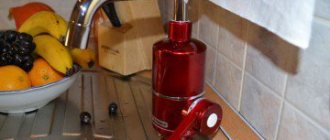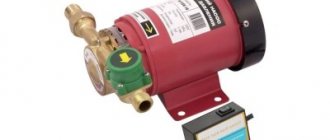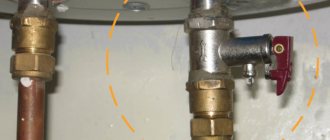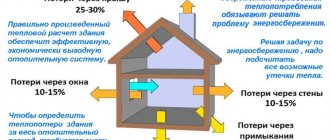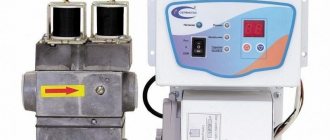Design and principle of operation
A ball valve is a design similar to a piece of pipe, but with an expanded middle section. This is where the seat made of sealing material is located. There is a shutter inside, which is easy to recognize by its round shape. This is where the shut-off valve got its name – ball valve.
The bolt rotates freely inside the seat. The design may have one, two or three through holes. In regulating models capable of redirecting the flow, there are two of them, if the tap is designed to adjust the pressure of hot or cold water. In faucets, the device is equipped with three holes.
The operating principle of a ball-type valve is based on aligning the axis of the ball hole with the axis of the device body. When the holes coincide, water flows. After turning the shutter 90 degrees, the flow is blocked by the side of the ball where there is no hole.
Design components:
- frame;
- O-rings;
- control lever;
- galvanized steel screw;
- rotating metal sphere with holes;
- stock;
- Teflon valve seals.
The flow intensity is adjusted by rotating the shutter 45 degrees. The hole in the ball is partially blocked, due to which the jet becomes weaker.
The shutter is controlled using a rod that is connected to a lever. The rod is equipped with sealing rings on both sides. For tightness, the hole in the body that allows the rod to pass through also has an O-ring and a washer.
Heating system setup, repairs
When installing a heating system, it is important not to make a mistake with the diameter of the pipes that connect to the wiring of the heating radiators. An important parameter is the number of battery sections , which determine the temperature regime. However, to perform coordinated adjustments, you can get by with control valves.
The process of setting up a heating system involves a number of nuances:
- Care should be taken to install precise and smooth adjustment regulators on all batteries. Ball valves will not cope with this role;
- If you have your own boiler room, the owner needs to find out which room is the coldest and install a thermostat in it;
- When screwing the taps, you need to ensure that the flow gradually weakens.
Advantages and disadvantages
Ball valves are widely used in various piping systems. The popularity of shut-off valves is due to the following advantages:
- compact parameters;
- efficiency and reliability of operation;
- simple installation method;
- convenient control of the mechanism;
- high degree of tightness;
- maintainability;
- a wide range of types and sizes of fittings;
- durability due to a large resource;
- affordable prices.
The reliability and durability of a ball valve depends on the type of material used, the quality of assembly and the ability to withstand operating loads. Experts advise giving preference to products from well-known manufacturers.
The disadvantages of the ball design are:
- periodic clogging of the valve opening;
- accumulation of salt deposits, which complicates the operation of shut-off valves;
- possible damage to the faucet by grains of sand and rust particles, which can lead to water leakage;
- low wear resistance of low-quality products; under the influence of load, the fittings leak.
When using a ball valve, it is worth considering that the design is intended for operation at positive temperatures. If the liquid freezes inside the case, the ice expands, which leads to rupture of the mechanism.
To prevent the build-up of salt deposits, it is recommended to turn the faucet handle every couple of months for preventive purposes.
Criterias of choice
The following criteria will help you decide on the choice of a suitable ball valve.
Manufacturer
There are products from different manufacturers on the market. Many brand names mean nothing to the average person. Purchasing products of unknown origin is a lottery. In order not to waste time and money, it is recommended to trust the professionals. Large enterprises producing shut-off valves are equipped with their own laboratories and staffed with highly qualified specialists. Therefore, special attention is paid to the quality of products.
Among the manufacturers that deserve trust:
- GEKON;
- Giacomini;
- VALFEX;
- BUGATTI;
- TERMA;
- Valtec;
- NEPTUN;
- ROSTerm.
Purpose
Ball valves of different types are produced according to their intended purpose: for water, heating systems, gas. When choosing a heating option, it is important to consider the temperature range of the working environment. The maximum usually reaches 90 degrees, while for a cold pipeline the figure is 30-40 degrees.
Gas and water taps have characteristic differences:
- the length of products for gas is longer, the thread is 1-2 turns longer;
- there is a hole for a seal on the body of the gas valve, but there is none on the water fittings;
- The color of the gas design butterfly is always yellow; for water they use blue, red, etc. tones;
- The valve stem seal for water is made of PTFE Teflon, for gas – of Viton
Material
The main materials for the manufacture of ball valves are steel (various grades, including stainless steel) and brass. Steel models are used primarily on industrial pipelines.
Brass products are considered more durable and reliable. Their service life often exceeds 10 years. Do not confuse brass with silumin, from which fakes are made. You can distinguish a high-quality alloy by its heavy weight (the fake is lighter).
Not so long ago, polypropylene taps made of high-strength plastic appeared on sale. Their peculiarity lies in their inertness to corrosive processes. The disadvantage is that it cannot be used on pipelines that transport hot water.
Polypropylene products are widely used in everyday life. The design feature is the absence of rigid fixation with the rod. The movement of the ball occurs under the influence of water flow.
Connection type
- Coupling fittings are the most common type, allowing multiple repairs of the system; depending on whether the pipe fittings are screwed in or screwed in, they are marked with BP/HP values; VR/VR; HP/NR.
- Flanged - joining of pipeline elements is carried out using flanges, features - maintainability, periodic tightening of bolts.
- Clamping - the connection is made using clamping fittings.
- Welded - installation is carried out using a welding machine (with perfect tightness, there is a significant disadvantage - during repairs it is necessary to dismantle part of the pipeline).
- Combined - characterized by the presence of internal and external threads, one side is attached with a coupling, the other with a nipple fitting.
Diameter
When selecting a ball valve, consider the diameter of the outlet or fittings. The indicator is marked with the letters Du. The standard mesh consists of the following options: DN 15 (1/2″), DN 20 (3/4″), DN 25 (1″), DN 32 (1 1/4″), DN 40 (1 1/2″ ), DN 50 (2″).
Crane type
According to the type of body, the products are: straight, angular, for connecting to a hose, three-way. The model is selected taking into account the location of the fittings on the pipeline and the type of communications.
Crane Features
Depending on the modification of the fittings, models with a union nut, drain valve, and filter are available. Additional devices increase the functionality of the crane and expand its scope of application.
A product with a union nut ends with an internal thread, and not an external one, as in fittings with a coupling. Thanks to this solution, the installation length is reduced and the number of connections is reduced.
Faucets equipped with a coarse filter are considered more protected from breakdowns and blockages.
Fittings with a bleed valve allow you to quickly get rid of air pockets in the system.
Control knob
The ball valve valve is controlled by a lever, flag, butterfly or valve. Models powered by electric drive are also available.
Nominal tap pressure
The following markings are provided for the fittings: Ru 10, Ru 16, Ru 25, Ru 40. The indicator reflects the highest operating pressure at a system ambient temperature of 20 degrees. The higher the value, the higher the faucet’s resistance to water hammer occurring in the heating or water supply pipeline.
Maximum temperature, °C
The maximum working environment reaches 180-200 degrees. When choosing fittings, you should take into account its purpose and temperature indicators specified in the technical characteristics of the model.
How to properly install a ball valve on water
Thanks to the simple design of the faucet, you can install it yourself. The location for the shut-off valves is selected taking into account unobstructed access and the absence of the risk of mechanical damage.
To work you will need:
- pipe cutter (if there is a need to cut the pipeline);
- metal hacksaw or plastic pipe scissors;
- plumbing wrenches (adjustable or gas);
- measuring devices;
- sealing material (FUM tape, tow);
- welding (if a welded connection type is selected).
Installation of the ball valve is possible both on plastic and metal pipes. The work algorithm consists of the following stages:
- covering the riser;
- dismantling the old tap (if you plan to install the fittings in a new location, cut lines are marked on the pipe);
- cleaning the threads from remnants of tow or other sealing material (at this stage the threads are checked for defects, the number of turns should not be less than four);
- fitting the tap in accordance with the installation length;
- winding the sealing tape onto the thread is carried out as the coupling is screwed on (to ensure tightness, all connections are made in this way);
- installation of a new shut-off device (it is important to control the position of the arrow on the body; it must coincide with the water flow in the pipeline).
Upon completion of the work, the riser is opened, the working condition of the fittings and the tightness of the connections are checked.
When operating a lever or butterfly, you must make sure that nothing interferes with the movement of the handle.
What is better: faucet or valve?
A homeowner often faces this question. And I must say that there is no clear answer to it. We can only note that the ball valve is easy to operate. The shut-off valve, in contrast, must be turned several times; this is the only way to limit or increase the supply of the working medium.
The faucet includes valves with gaskets on them. After they have exhausted their service life, they can simply be replaced, the same applies to the oil seal. Ball valves do not cause such problems. The only thing is that it is necessary to periodically inspect them and, if a leak is detected, take replacement measures.
If hard water circulates in the heating network, then it makes sense to think about installing a shut-off valve; if problems arise, it can be repaired, since the ball valve will have to be replaced.
The price of the issue also plays an important role.
A little about refusals
Unfortunately, failures in the heating system are not that uncommon. This is due to the low quality of the pipeline fittings used. In particular, these include ball valves made of silumin, as discussed above, and the use of low-quality substitutes instead of fluoroplastic.
Currently reading
- How it works and how the Mayevsky crane works
- Why are coupling cranes pushing their counterparts out of the market?
- Applications for double control taps
- What are the purposes of three-way valves in water supply?
Marking of ball valves
Often, markings for ball valves are developed individually by manufacturers. However, there are standard regulations that apply to products manufactured by Russian manufacturers and importers selling their products in the Russian Federation.
What does the marking according to GOST 527/60 include:
- Date of issue;
- nominal bore/diameter (DN);
- an arrow indicating the flow movement;
- nominal pressure (PN);
- working/design pressure;
- Max. operating temperature.
GOST 4666 determines the color of taps by purpose and type of material:
- Cast iron products are marked black;
- blue or light blue – stainless steel;
- red – fittings intended for hot water.
In addition to the basic values, additional information may be indicated on the valve. For example, phase state of the medium, explosion hazard sign, max. or min. pressure drop, etc.
Recommendations for choosing a ball valve
Now that we have figured out what this or that type of ball valve is intended for, we can begin to select it. It should be remembered that this type of fittings is not used to regulate the amount of water, but only performs shut-off functions. The exception is devices with servo drives. It is better to make a specific selection of a tap knowing the operating parameters of the coolant. If there is no such information, then it is enough to know that for systems of private houses, fittings in a coupling design with a working pressure of up to 10 Bar and a temperature of up to 120 ºC are quite sufficient.
If we are talking about centralized networks, then for heating it is better to use ball valves with a working pressure of up to 16 Bar and higher. When selecting fittings for central heating, you need to be careful and provide a decent pressure margin. The reason is unpredictable parameter jumps due to water hammer.
Separately, we will give a warning about counterfeits, which fill all plumbing markets. The Chinese cheap faucet is made of silumin, it is very fragile and often cannot withstand even tightening with a wrench. In addition, the material is susceptible to electrochemical corrosion, which destroys it within a couple of years. At the same time, it has become very difficult to recognize a fake. The only recommendation on this topic: buy fittings from trusted people or in trusted stores, even if you choose a small tap for heating radiators.

